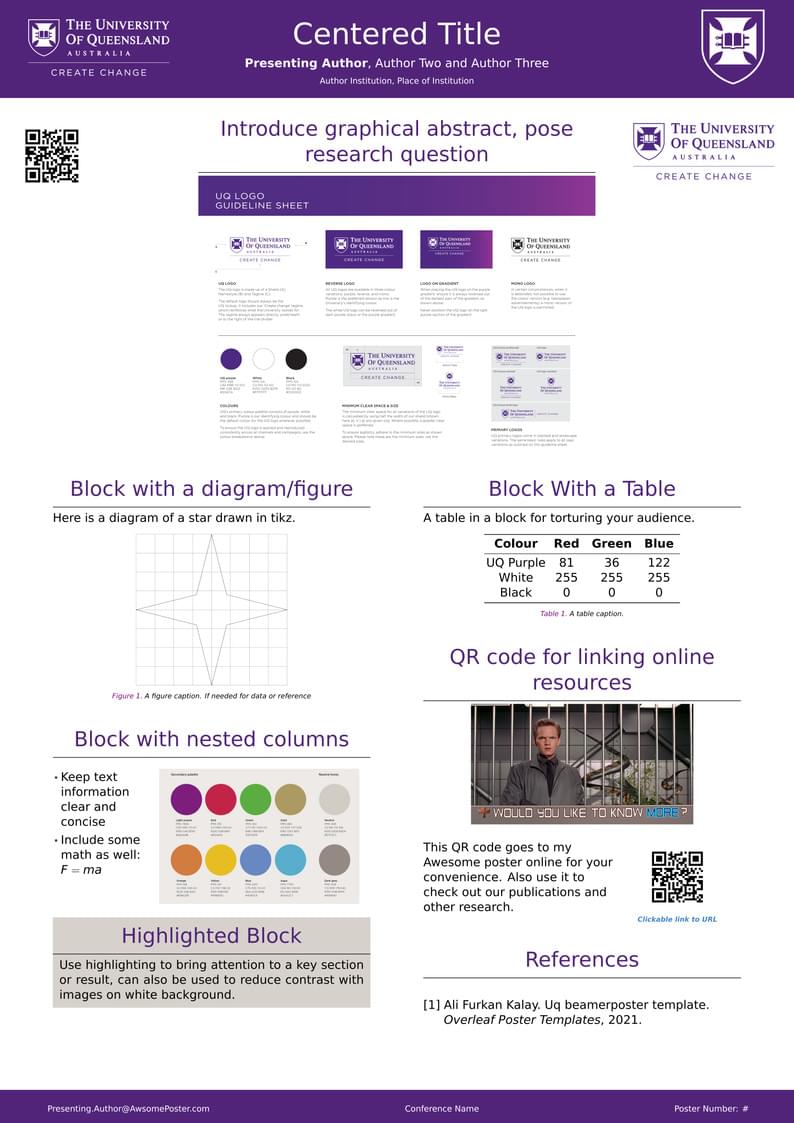
UQ Poster Theme
Author:
Raymond A Harrison
Last Updated:
4年前
License:
Creative Commons CC BY 4.0
Abstract:
A poster template with UQ branding for academic posters.

\begin
Discover why over 20 million people worldwide trust Overleaf with their work.
A poster template with UQ branding for academic posters.

\begin
Discover why over 20 million people worldwide trust Overleaf with their work.
% UQ QOL/EQUS Poster format
% Forked from: https://www.overleaf.com/project/618cc965bcbc81513871601f
% Credit: Ali Furkan Kalay
% See: https://github.com/alfurka/gemini-uq
% Forked from
% https://rev.cs.uchicago.edu/k4rtik/gemini-uccs
% which is forked from
% https://github.com/anishathalye/gemini
\documentclass[final]{beamer}
% ====================
% Packages
% ====================
\usepackage[T1]{fontenc}
\usepackage{lmodern}
\usepackage[orientation=portrait,size=a0,scale=1.0]{beamerposter} % Current dimensions A0, put in your poster dimensions
\usetheme{gemini}
\usecolortheme{uchicago}
\usepackage{graphicx}
\usepackage{caption}
\usepackage{booktabs}
\usepackage{tikz}
\usepackage{pgfplots}
\pgfplotsset{compat=1.17}
\newcommand{\blu}{\color{blue}}
\usepackage{DejaVuSans}
%%%%%%%%%%%%%%%%%%%%%%%%%%%%%%%%%%%%%%%%%%%%%%%%%%%%%%%%%%%%%%%%%%%%%%%%%%%%%%
% Column environment setup
%%%%%%%%%%%%%%%%%%%%%%%%%%%%%%%%%%%%%%%%%%%%%%%%%%%%%%%%%%%%%%%%%%%%%%%%%%%%%%
% If you have N columns, choose \sepwidth and \colwidth such that
% (N+1)*\sepwidth + N*\colwidth = \paperwidth
% Follow structure to create difference column environments.
\newlength{\sepwidthA} % Seperation distance between comulumns type A
\newlength{\colwidthA} % collumn width type A
\setlength{\sepwidthA}{0.25\paperwidth}
\setlength{\colwidthA}{0.5\paperwidth}
\newcommand{\separatorcolumnA}{\begin{column}{\sepwidthA}\end{column}}
% Second column environment.
\newlength{\sepwidthB}
\newlength{\colwidthB}
\setlength{\sepwidthB}{0.0666\paperwidth}
\setlength{\colwidthB}{0.4\paperwidth}
\newcommand{\separatorcolumnB}{\begin{column}{\sepwidthB}\end{column}}
% You can also use these column commands to create columns inside columns and for creating new column formatting.
% You can also have non even columns by creating more column environments or specifying the width when beginning a column environment.
%%%%%%%%%%%%%%%%%%%%%%%%%%%%%%%%%%%%%%%%%%%%%%%%%%%%%%%%%%%%%%%%%%%%%%%%%%%%%%
% Title
%%%%%%%%%%%%%%%%%%%%%%%%%%%%%%%%%%%%%%%%%%%%%%%%%%%%%%%%%%%%%%%%%%%%%%%%%%%%%%
\title{\VeryHuge{Centered Title}}
\author{\textbf{Presenting Author}, Author Two and Author Three}
\institute[shortinst]{Author Institution, Place of Institution}
%%%%%%%%%%%%%%%%%%%%%%%%%%%%%%%%%%%%%%%%%%%%%%%%%%%%%%%%%%%%%%%%%%%%%%%%%%%%%%
% Poster footer
%%%%%%%%%%%%%%%%%%%%%%%%%%%%%%%%%%%%%%%%%%%%%%%%%%%%%%%%%%%%%%%%%%%%%%%%%%%%%%
\footercontent{
\href{mailto:Presenting.Author@AwsomePoster.com}{Presenting.Author@AwsomePoster.com} % this is a clickable link
\hfill
Conference Name \hfill
{Poster Number: \#} }
% (can be left out to remove footer)
\begin{document}
%%%%%%%%%%%%%%%%%%%%%%%%%%%%%%%%%%%%%%%%%%%%%%%%%%%%%%%%%%%%%%%%%%%%%%%%%%%%%%
% Logo placements (optional)
%%%%%%%%%%%%%%%%%%%%%%%%%%%%%%%%%%%%%%%%%%%%%%%%%%%%%%%%%%%%%%%%%%%%%%%%%%%%%%
\addtobeamertemplate{headline}{}
{
%\begin{tikzpicture}[remember picture,overlay] % Solid header bar
\begin{tikzpicture}[remember picture,overlay,line width=\arrayrulewidth] % gradient header bar
% UQ Reverse Logo
\node [anchor=north west, inner sep=3cm] at ([xshift=0cm,yshift=1.0cm]current page.north west)
{\includegraphics[height=6.0cm]{logos/UQlockup-Reverse-cmyk.eps}};
% Logo 1, replace with custom logo
\node [anchor=north east, inner sep=3cm] at ([xshift=0.0cm,yshift=2.0cm]current page.north east)
{\includegraphics[height=8.0cm]{logos/Logo-Right.png}};
% Extra logo 2
\node [anchor=north east, inner sep=3cm] at ([xshift=1.0cm,yshift=-10.0cm]current page.north east)
{\includegraphics[height=6.0cm]{logos/UQlockup-Purple-cmyk.eps}};
% Extra logo 3, or a QR Code
\node [anchor=north west, inner sep=3cm] at ([xshift=-1.0cm,yshift=-10.0cm]current page.north west)
{\includegraphics[height=7.0cm]{Figures/ChristopherGBaker_URL.eps}};
\end{tikzpicture}
}
% ====================
% Body
% ====================
\begin{frame}[t]
%%%%%%%%%%%%%%%%%%%%%%%%%%%%%%%%%%%%%%%%%%%
%Section 1
%%%%%%%%%%%%%%%%%%%%%%%%%%%%%%%%%%%%%%%%%%%
\begin{columns}[t]
\separatorcolumnA
\begin{column}{\colwidthA}
\begin{block}{Introduce graphical abstract, pose research question}
\begin{figure}
\centering
\includegraphics[width=1.0\textwidth]{logos/UQ_Logo_Gudelines_Sheet.pdf}
\end{figure}
\end{block}
\end{column}
\separatorcolumnA
\end{columns}
%%%%%%%%%%%%%%%%%%%%%%%%%%%%%%%%%%%%%%%%%%%
%Section 2
%%%%%%%%%%%%%%%%%%%%%%%%%%%%%%%%%%%%%%%%%%%
\begin{columns}
%%%%%%%%%%%%%%%%%%%%%%%%%%%%%%%%%%%%%%%%%%%
%Section 2 column 1
%%%%%%%%%%%%%%%%%%%%%%%%%%%%%%%%%%%%%%%%%%%
\separatorcolumnB
\begin{column}[T]{\colwidthB}
\begin{block}{Block with a diagram/figure}
Here is a diagram of a star drawn in tikz.
\begin{figure}
\centering
\begin{tikzpicture}[scale=8]
\draw[step=0.25cm,color=gray] (-1,-1) grid (1,1);
\draw (1,0) -- (0.2,0.2) -- (0,1) -- (-0.2,0.2) -- (-1,0)
-- (-0.2,-0.2) -- (0,-1) -- (0.2,-0.2) -- cycle;
\end{tikzpicture}
\caption{A figure caption. If needed for data or reference}
\end{figure}
\end{block}
\begin{block}{Block with nested columns}
\begin{column}{0.3\colwidthB}
\begin{itemize}
\item Keep text information clear and concise
\item Include some math as well: $ F = ma $
\end{itemize}
\end{column}
\begin{column}{0.7\colwidthB}
\begin{figure}
\centering
\includegraphics[width=0.9\textwidth]{logos/UQ_Secondary_Colour_Palette.PNG}
\end{figure}
\end{column}
\end{block}
\begin{alertblock}{Highlighted Block}
Use highlighting to bring attention to a key section or result, can also be used to reduce contrast with images on white background.
\end{alertblock}
\end{column}
\separatorcolumnB
%%%%%%%%%%%%%%%%%%%%%%%%%%%%%%%%%%%%%%%%%%%
%Section 2 column 2
%%%%%%%%%%%%%%%%%%%%%%%%%%%%%%%%%%%%%%%%%%%
\begin{column}[T]{\colwidthB}
\begin{block}{Block With a Table}
A table in a block for torturing your audience.
\begin{table}
\centering
\begin{tabular}{c c c c}
\toprule
\textbf{ Colour } & \textbf{ Red } & \textbf{ Green } & \textbf{ Blue } \\
\midrule
UQ Purple & 81 & 36 & 122 \\
White & 255 & 255 & 255 \\
Black & 0 & 0 & 0 \\
\bottomrule
\end{tabular}
\caption{A table caption.}
\end{table}
\end{block}
\begin{block}{QR code for linking online resources}
\begin{figure}
\centering
\includegraphics[width=0.7\textwidth]{Figures/WouldYouLikeToKnowMore.jpg}
\end{figure}
\begin{column}[T]{0.6\colwidthB}
This QR code goes to my Awesome poster online for your convenience. Also use it to check out our publications and other research.
\end{column}
\begin{column}[T]{0.4\colwidthB}
\begin{figure}
\centering
\includegraphics[width=0.5\textwidth]{Figures/ChristopherGBaker_URL.eps}
\captionsetup{labelformat=empty}
\caption{\href{https://www.christophergbaker.com}{\textbf{\blu{Clickable link to URL}}}}
\end{figure}
\end{column}
\end{block}
%%%%%%%%%%%%%%%%%%%%%%%%%%%%%%%%%%%%%%%%%%%%%%%%%%%%%%%%%%%%%%%%%%%%%%%%%%%%%%
% References
%%%%%%%%%%%%%%%%%%%%%%%%%%%%%%%%%%%%%%%%%%%%%%%%%%%%%%%%%%%%%%%%%%%%%%%%%%%%%%
\begin{block}{References}
\nocite{*}
\bibliography{poster}% Produces the bibliography via BibTeX.
\bibliographystyle{plain}
\end{block}
\end{column}
\separatorcolumnB
\end{columns}
\end{frame}
\end{document}